We have been seeing higher numbers of Spotted Lanternfly in Lancaster county recently. Here are some common questions people have about Spotted Lanternfly or SLF. We’ll also do our best to answer those questions based on available research.
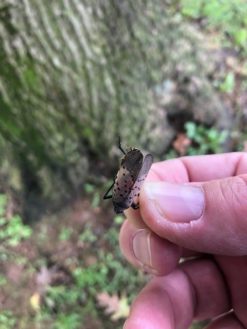 A couple of notes on this particular pest before we get started. Please keep in mind:
A couple of notes on this particular pest before we get started. Please keep in mind:
- This information changes constantly as we learn more about this pest. Please continue to refer to materials from both Penn State and the Pennsylvania Department of Agriculture for more, updated information periodically.
- There is no “silver bullet” or “one-size-fits-all” program for this pest. Each situation is truly unique when it comes to management for this pest. A variety of factors come into play with each property. So, while a professional may be able to help you with certain parts of managing this pest, no chemical control program is “the fix” for keeping the Spotted Lanternfly population under control.
Background
Spotted Lanternfly is a type of pest called a “planthopper,” meaning it moves from plant to plant in order to feed. It is native to China, where predators provide a measure of control.
Part of the reason for the spread of Spotted Lanternfly in Lancaster County is that there are not biological control methods. In other words, it has no disease or predators we know of that feed on it.
Life Cycle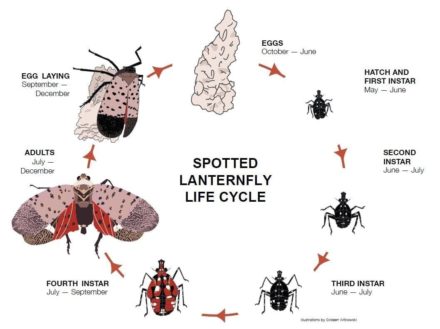
Spotted Lanternfly adults are most active laying eggs right now. They will continue to lay eggs from now until we have a hard frost, which should kill the adult population.
Egg masses will overwinter wherever they are laid. Nymphs will emerge in late Spring or early Summer, and begin to feed. These nymphs go through four instars (developmental stages) before becoming adults. The first three instars have a black body with white spots. The fourth instar has a black and red body, also with white spots.
Adult Spotted Lanternfly will have two sets of wings. The outer wings gray, semi-translucent wings. These wings will have black spots on them with gray veins. The hidden set of wings are a bright red, giving the semi-translucent outer wings a pinkish hue underneath the gray.
The adult stage of Spotted Lanternfly is the most mobile. Spotted Lanternfly will lay eggs on almost any surface, not just trees. Old wood or logs laying around, cars, grills, RV’s and trailers, and mailboxes are all places SLF has been known to lay eggs.
The one thing all experts seem to agree on is that Spotted Lanternfly seems to require ailanthus altissima trees (Chinese sumac or “Tree of Heaven”) to reproduce. Identifying the location of these trees an eliminating them is crucial.
Note: Life Cycle illustration used courtesy of Penn State University, with permission.
Damage to Property
Spotted Lanternfly can certainly damage your landscape plants. It is safe to say that as of this posting, the chances of SLF damaging your property in 2018 are slim to none.
Spotted Lanternfly damages plants by the way it feeds on them. It has what entomologists call “piercing/sucking mouthparts” which it inserts into the tree. Think of a mosquito that feeds on the 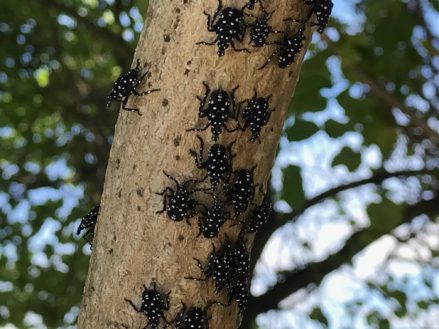 fluid inside of plants instead of blood, and you’ve got the right idea.
fluid inside of plants instead of blood, and you’ve got the right idea.
The damage occurs when SLF nymphs and adults are in high numbers – they typically feed en masse, which is where the damage occurs. They can quite literally suck a tree dry. Often, they secrete a sticky substance called “honeydew” when they feed. Other insects can do this as well, like aphid and scale pests on a tree or shrub. This honeydew encourages the growth of a black mold on bark and leaves called “black sooty mold,” which can be an indicator of Spotted Lanternfly feeding.
Spotted Lanternfly prefers to feed on plants that have a higher sugar content in their sap. For Pennsylvania agriculture and businesses, the economic impact cannot be overstated. According to the Pennsylvania Department of Agriculture “This pest poses a significant threat to the state’s more than $28 million grape, $87 million apple, and more than $19 million peach industries, as well as the hardwood industry in Pennsylvania which accounts for nearly $17 billion in sales.”
For your landscape, there are certain plants that you should be concerned about. Spotted Lanternfly seems to prefer trees with a high sugar content in their sap. Vulnerable trees include ornamental fruit trees like cherry, plum, pear, and crabapple trees, as well as maples and possibly poplar trees.
Control for Spotted Lanternfly
There are several ways you can help control the spread of this invasive pest.
Removing Ailanthus trees
It is widely recognized that Spotted Lanternfly requires the ailanthus altissima to reproduce. This tree is the spotted lanternfly’s primary target. Because of this fact, one of the primary steps you can take to slow the spread of this pest is to remove these trees from your property. This is a must for managing this pest!
Control for ailanthus trees is never simple – they’re very hardy plants! What is generally recognized as the most effective control method is called “hack and squirt,” and involved cutting notches in the bark around the circumference of the tree. Once these notches have been cut into the tree, herbicide should be applied directly into the wound.
A selective herbicide containing the chemical triclopyr may be used without damage to plants around the ailanthus tree. However, if you are not a registered pesticide applicator in Pennsylvania and want to DIY this, a product with glyphosate (like Roundup) will work. Use caution, however – not only are you applying an herbicide, but glyphosate is non-selective, meaning it kills any plant it touches. If you don’t want to damage other plants around the tree, you may want to contract a professional to help.
Removing egg masses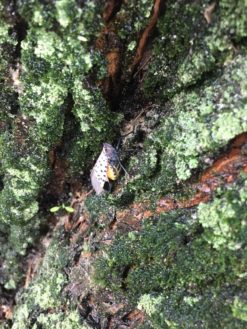
During Fall and Winter months, and after a hard freeze, it’s a great idea to inspect your property. Look closely at the siding on your home, your cars, your grill, the trailer or RV, mailbox, trees and shrubs on the property, old piles of debris – give it a thorough inspection!
You should also inspect your cars any time you’re leaving the quarantine zone for egg masses. If you’re going to be travelling to York, Dauphin, Cumberland, or Perry Counties, you should be inspecting your vehicle before you travel to ensure you’re not transporting SLF outside the quarantine zone.
If you see the eggs masses from Spotted Lanternfly, scrape them into a bottle or sandwich bag containing rubbing alcohol or hand sanitizer. This will kill the eggs so they do not hatch. If using the sandwich bag, it is recommended that you double bag, just to be safe. Any scraped egg masses should be thrown in the garbage and disposed of immediately.
Sticky bands
When nymphs first hatch in late Spring or early Summer, they tend to migrate to the fresher, greener parts of the tree where the new growth is to begin feeding. And this makes sense; it could their piercing/sucking mouthparts may not be as developed yet, and unable to penetrate more mature bark. Whatever the reason, it gives people trying to control their spread another tool in the arsenal – “sticky bands.”
The basic idea is simple: wrap the trunk of the tree in a sticky material that the nymphs will get stuck on. If they can’t get free and feed, they’ll certainly never reach adulthood! The Spotted Lanternfly Management for Homeowners published by Penn State even recommends simply using duct tape, and wrapping in backwards, tightly around the tree as an effective method for controlling nymphs.
Homeowners who are concerned about slowing the spread of this pest should target the trees we’ve mentioned first. Then, move on to other trees on their property with this same method. Sticky bands should be re-applied weekly during nymph stages (late May to September) for best results.
Chemical control
This should be considered a final “backstop” to the other control methods we’ve outlined so far in this post. There isn’t a ton of information about what’s really effective on this pest right now. While experts agree that their nervous system is disrupted by available pesticides, none are presently labelled for use on the Spotted Lanternfly.
What seems to be working for now is a combination of two different pesticide approaches. These are commonly referred to as systemic and contact pesticides. Systemic pesticides are products that the plant material absorbs, and it stays inside the plant itself. This is how products like grub control work for your lawn – the product is absorbed into the plant, and when an insect feeds, it ingests this product.
By contrast, contact pesticides are just what they sound like – they work on contact with the bug. Examples of contact products most homeowners are familiar with are Raid and Black Flag for things like spiders and ants. And, like those over-the-counter products, many contact pesticides also include a residual effect. This means that they’ll continue to kill bugs for a period of time (depending on the product used, rate of application, rainfall, etc.) after the application is completed.
Systemic products seem to be having a really good results with the nymph stage of the Spotted Lanternfly right now. The adult stage, being far more mobile, is much better controlled by contact products with regular follow up applications.
Frequently Asked Questions
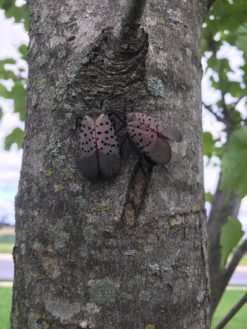 Will this kill my tree?
Will this kill my tree?
In short, the answer from most experts at this point is that we don’t know for certain. Again, we do know that trees with a high sugar content in the sap are most vulnerable. Pears, cherries, plums, apples, crabapples, maples, and possibly poplars are at risk. You would do well to apply non-chemical control methods (scraping egg masses, sticky bands) to these trees. Also contracting a professional for the control if they feel equipped to handle the issue could help.
Can it bite me or my kids/pets?
No, we have no reason to believe that SLF is biting or causing any harm to people or pets.
My tree is dying – has the Spotted Lanternfly already killed it?
No, it is extremely unlikely that any tree in Lancaster County is suffering the effects of SLF damage right now. We’ve had an abnormal amount of rainfall, which has caused widespread disease issues across the are with all kinds of plants. It is more likely to be a disease, or stress from another landscape pest, than damage from Spotted Lanternfly.
If you have additional concerns about Spotted Lanternfly, we’d be happy to talk to you. Please Contact Us for more information.
The post Spotted Lanternfly in Lancaster County appeared first on Tomlinson Bomberger.
from Tomlinson Bomberger https://ift.tt/2IqcMnk
No comments:
Post a Comment